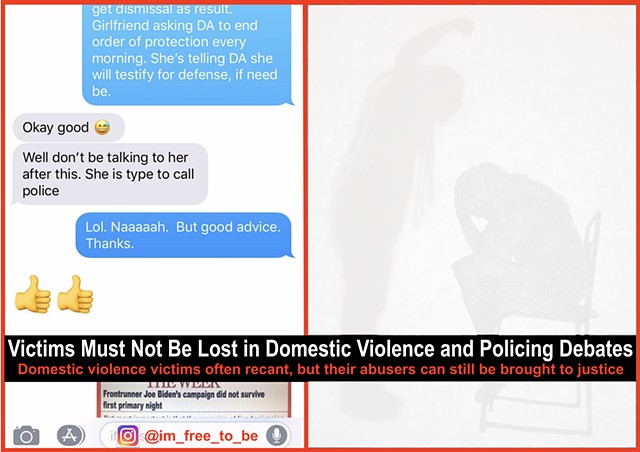unhinged
Image on left:
Text between a public defender/enabler and the perpetrator. The lawyer is collaborating with the perpetrator, closing all access for victims to seek protection and accountability, perpetuating violence. Normalizing coercive control and therefore violence in the home.
*How Abusers Trick Survivors Into Denying Abuse
*Explaining DARVO: Deny, Attack, Reverse Victim & Offender
*Victims Must Not Be Lost in Domestic Violence and Policing Debates
*Domestic violence victims often recant, but their abusers can still be brought to justice
*Coercive Control
*What Kind Of Person Is Likely To Carry Out Coercive Control In Their Relationships?
*Profile of an Abuser:
✓Jealousy; questioning partner constantly about whereabouts, jealous of the time she spends away from him
✓Controlling behavior; the victim cannot get a job, leave the house, or bathe without permission
✓Isolation; makes the victim move away from family and friends so they solely depend on the abuser for support
✓Forces sex against partner's will
✓Holds very rigid gender roles; the partner's job is to cater to the abuser
Coercive control: Coercive control is an act or a pattern of acts of assault, threats, humiliation and intimidation or other abuse that is used to harm, punish, or frighten their victim. This controlling behaviour is designed to make a person dependent by isolating them from support, exploiting them, depriving them of independence and regulating their everyday behaviour.
We campaigned and succeeded in making coercive control a criminal offense. This has marked a huge step forward in tackling domestic abuse. But now we want to make sure that everyone understands what it is.
Coercive control creates invisible chains and a sense of fear that pervades all elements of a victim’s life. It works to limit their human rights by depriving them of their liberty and reducing their ability for action. Experts like Evan Stark liken coercive control to being taken hostage. As he says: “the victim becomes captive in an unreal world created by the abuser, entrapped in a world of confusion, contradiction and fear.”
Flashbacks PTSD and Abuse: “Domestic violence frequently occurs in a repetitive series of violent or harmful incidents, so a survivor’s mind is too focused on preparing for the next violent incident to properly process the previous trauma. As a result, the mind struggles to heal years later, meaning symptoms of sensory overload, vivid flashbacks, and physical discomfort can appear several years after a survivor has escaped abuse. In fact, 88% of women in domestic violence shelters suffer from Post Traumatic Stress Disorder (PTSD).”
Healing through the arts: “Recent research shows that traumatic memories are stored in the right back region of the brain, which is associated with non-verbal memories (sights, sounds, and smells associated with a past event), rather than the left front area of the brain, which is associated with verbal memories. This means that commonly recommended self-care activities like journaling, talking to a friend, or even traditional talk therapy might not be the most effective strategies for working through those memories and the emotional and physical reactions attached to them.
Art expression (in all its forms) activates the right brain because it incorporates your senses by providing tactile, kinesthetic, auditory, and/or visual information. This means that arts activities can tap into traumatic memories the way that other, less sensory activities cannot. There is evidence that engagement with artistic activities, either as an observer or as an initiator, can enhance your mood, emotions, and other psychological states, while reducing symptoms like stress and depression.”
#silenceisviolence
#domesticviolence
#narcissisticabuse
#narcissisticdomesticabuse
#coercivecontrol
#lovebombing
#traumabonding
#futurefaking
#flyingmonkeys
#emotionalabuse
#sexualabuse
#intimatepartnerrape
#genderbasedviolence
#misogyny
#accountability
